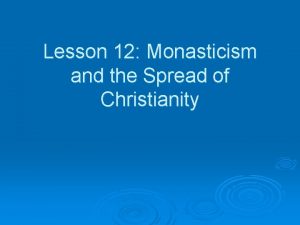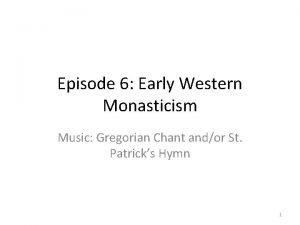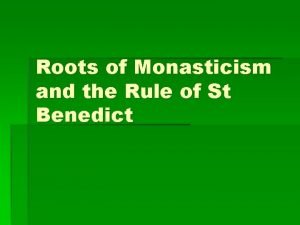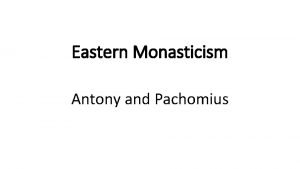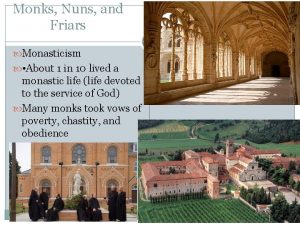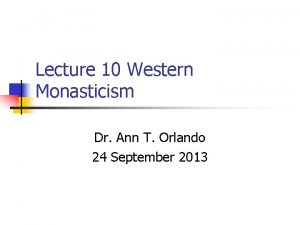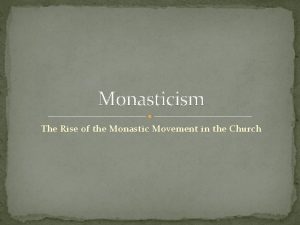Monasticism 1 What is monasticism What are the










- Slides: 10

Monasticism 1. What is “monasticism”? What are the characteristics of the monastic life? 2. Give an example that shows the Biblical origin of the monastic life. 3. What are the forms of monasticism and who was the leader of each?

Monasticism Asceticism / Ascetic Life • Chosen life of poverty, solitude, and abstinence. • Renouncement of social life and comfort for solitude, self-mortification, & religious devotion; leading a very austere (rigidly abstinent) and self-denying life. Jesus said to him, “If you want to be perfect, go, sell what you have and give to the poor, and you will have treasure in heaven; and come, follow Me. ” (Mat 19: 21) The Coptic Church offered many leaders in the monastic life; most famous worldwide are: St. Anthony the Great (c. 251 -356 A. D. ) – the father of monastic family worldwide St. Syncletiki (4 th century) – leader of monastic life for women The Monastery of St. Anthony the Great Still Standing and Active in the Egyptian Eastern Desert Near the Red Sea Several Other Monasteries from the 4 th – 6 th Centuries are Still Standing and Active in the Egyptian Deserts

Monasticism - Biblical Fact MAT 16: 26 "For what profit is it to a man if he gains the whole world, and loses his own soul? Or what will a man give in exchange for his soul? MAT 19: 21 Jesus said to him, "If you want to be perfect, go, sell what you have and give to the poor, and you will have treasure in heaven; and come, follow Me. " MAR 10: 21 Then Jesus, looking at him, loved him, and said to him, "One thing you lack: Go your way, sell whatever you have and give to the poor, and you will have treasure in heaven; and come, take up the cross, and follow Me. " LUK 18: 22 So when Jesus heard these things, He said to him, "You still lack one thing. Sell all that you have and distribute to the poor, and you will have treasure in heaven; and come, follow Me. " MAT 25: 1 "Then the kingdom of heaven shall be likened to ten virgins who took their lamps and went out to meet the bridegroom. MAT 19: 11 But he said unto them, "All men cannot receive this saying, save they to whom it is given. For there are some eunuchs, which were so born from their mother's womb: and there are some eunuchs, which were made eunuchs of men: and there be eunuchs, which have made themselves eunuchs for the kingdom of heaven's sake. He that is able to receive it, let him receive it. " 1 CO 7: 1 -2 Now concerning the things whereof ye wrote unto me: It is good for a man not to touch a woman. Nevertheless, to avoid fornication, let every man have his own wife, and let every woman have her own husband. 1 CO 7: 6 -9 But I speak this by permission, and not of commandment. For I would that all men were even as I myself. But every man hath his proper gift of God, one after this manner, and another after that. I say therefore to the unmarried and widows, It is good for them if they abide even as I. But if they cannot contain, let them marry: for it is better to marry than to burn.

Monasticism The Coptic Church also offered the world several forms of monasticism • Anchoritic / Eremitic – St. Paul of Thebes, St. Mary of Egypt Anchorites / eremites / hermits living in solitude; own prayer, clothing, food & work. Anchorites with no specific cells but wandered in the desert: "wanderers / pilgrims". • Communal – St. Anthony: Eastern Desert; St. Amoun: Nitria; St. Macarius: Scetis Monks lived in a semi-eremitic life, in separate cells, and assembled occasionally for the Divine Liturgies and spiritual conferences. • Cenobitic – St. Pachomius in Upper (Southern) Egypt Monks (cenobites) lived in a community inside the walls of the monastery, in association with each other, and governed by an abbot and by rules. They all contributed to centuries of humble serving in educational, social and spiritual enrichment of humanity

Monasticism 1. What is “monasticism”? What are the characteristics of the monastic life? Chosen life of poverty, solitude, and abstinence. Renouncement of social life and comfort for solitude, self-mortification, & religious devotion; leading a very austere (rigidly abstinent) and self-denying life. 2. Give an example that shows the Biblical origin of the monastic life. MAT 16: 26 "For what profit is it to a man if he gains the whole world, and loses his own soul? Or what will a man give in exchange for his soul? LUK 18: 22 So when Jesus heard these things, He said to him, "You still lack one thing. Sell all that you have and distribute to the poor, and you will have treasure in heaven; and come, follow Me. " MAT 25: 1 "Then the kingdom of heaven shall be likened to ten virgins who took their lamps and went out to meet the bridegroom. 3. What are the forms of monasticism and who was the leader of each? • Anchoritic / Eremitic – St. Paul of Thebes, St. Mary of Egypt • Communal – St. Anthony: Eastern Desert; St. Amoun: Nitria; St. Macarius: Scetis • Cenobitic – St. Pachomius in Upper (Southern) Egypt

Monasticism 4. Name four of the areas where early monasticism sprung in Egypt and the form it took in each. 5. Name four of the 4 th century monasteries that are still standing in Egypt now? 6. Name four of the female leaders of monastic life among women.

The Leaders of Monastic Life - Men St. Paul of Thebes (the first hermit) During the persecution by Decius (250 A. D. ), he fled to the desert as his brother-in-law threatened to betray him. He enjoyed his life of solitude and contemplation until his death in 341 after the Divine Providence allowed St. Anthony to visit him. His story was written by St. Jerome as told by the disciples of St. Anthony the Great (the father of the monastic family) Born 251 Sold his possessions and devoted his life to asceticism 269 Took shelter in an abandoned tomb in the western desert Lived in solitude in the "outer mountain" at Pispir to the east of the Nile 286 Became a leader in ascetic life to a group of followers 306 Lived in solitude in the "inner mountain", Qolozum, near the Red Sea 311 Visited Alexandria during the persecution of Maximinus Daza 316 Visited Alexandria to support Pope Athanasius against Arianism 352 Died at age 105 356 St. Pachomius (the founder of the cenobitic system) Born 290 Was baptized at the time of Maximinus Daza 307 Became a disciple for a hermit named Palaemon 310 Established the first group at Tabennesis 315 Established monasteries for thousands of monks & a convent for 400 nuns Became sick at the spread of the plague and died

The Leaders of Monastic Life - Men (Cont. ) St. Amoun (Nitria and Cellia / Cells) Born 275 Married but lived as ascetic in Nitria 297 Settled in cells in the inner part of the mountain of Nitria 315 In a visit by St. Anthony, the cells or Cellia was established as the area of solitude for the anchorite St. Macarius of Egypt (Scetis) 330 - 390 His parents forced him to marry but he became sick and left to Wadi-el-Natroun. He lived an ascetic life in a hut far from the village until he fled to Scetis. God send him a Cherub to guide him in establishing the monastic life in Scetis. This Cherub accompanied him almost all his life. He led the monastic life in Scetis where he had many disciples who followed his way of living. An Arian bishop exiled him to an island in the Nile in his old age. He died shortly after his return. Monasteries of Scetis Monasteries of Baramous (of the Roman Brothers), Monastery of St. Macarius, Monastery of St. Pishoy, Monastery of the Syrians (of St. Mary), Monastery of the St. John the Short St. Shenouti (Archimandrite: the Head of Anchorites) Lived an ascetic life since his childhood through long fasting and prayers Lived with uncle Pygol, founder of the White Monastery Succeeded his uncle as the Abbot of the monastery (383 - 451) Accompanied St. Cyril to the Council of Ephesus in 431 Despite his love for solitude, he was a national leader (using the Coptic language, defending the oppressed) and a social reformer (helping and teaching the people) He led 2200 monks and 1800 nuns according to Besa his disciple

The Leaders of Monastic Life - Women St. Syncletiki Born of very rich parents Dedicated her life to God even in her parents' home After parents died, she sold everything and lived outside Alexandria in solitude She had many disciples and lived to be 80 Became very ill and endured many sufferings the last three years of her life St. Athanasius wrote her story St. Talida Leader of a group of nuns that sought ascetic excellence Founder of a convent near Fayoum Sixty nuns lived under her guidance and served the needy with cheerful hearts St. Sarah Guided many nuns and left many sayings that were treasured by the desert fathers St. Hilary The daughter of the Roman Emperor Zeno Lived in hiding in Scetis as one of the monks in complete solitude Her parents knew her place when she healed her sister who came seeking the prayer of the fathers in Scetis St. Mary of Egypt Life of repentance: from a disgraceful life in Egypt to a saintly life in the Jordan desert She lived in total isolation until discovered by St. Zosima

Monasticism 4. Name three of the areas where early monasticism sprung in Egypt and the form it took in each. In the Egyptian Eastern Desert near the Red Sea: Anchoritic and Communal St. Paul and St. Anthony In the Egyptian Western Desert: Anchoritic and Communal Nitria, Cellia / Cells and Scetis St. Amoun and St. Macarius In Upper (Southern) Egypt: Cenobitic St. Pachomius 5. Name four of the 4 th century monasteries that are still standing in Egypt now? In the Egyptian Eastern Desert near the Red Sea: The Monastery of St. Anthony the Great In the Egyptian Western Desert: Monasteries of Baramous (of the Roman Brothers) Monastery of St. Macarius, Monastery of St. Pishoy Monastery of the Syrians (of St. Mary) 6. Name four of the female leaders of monastic life among women. St. Syncletiki St. Talida St. Sarah St. Hilary St. Mary of Egypt












